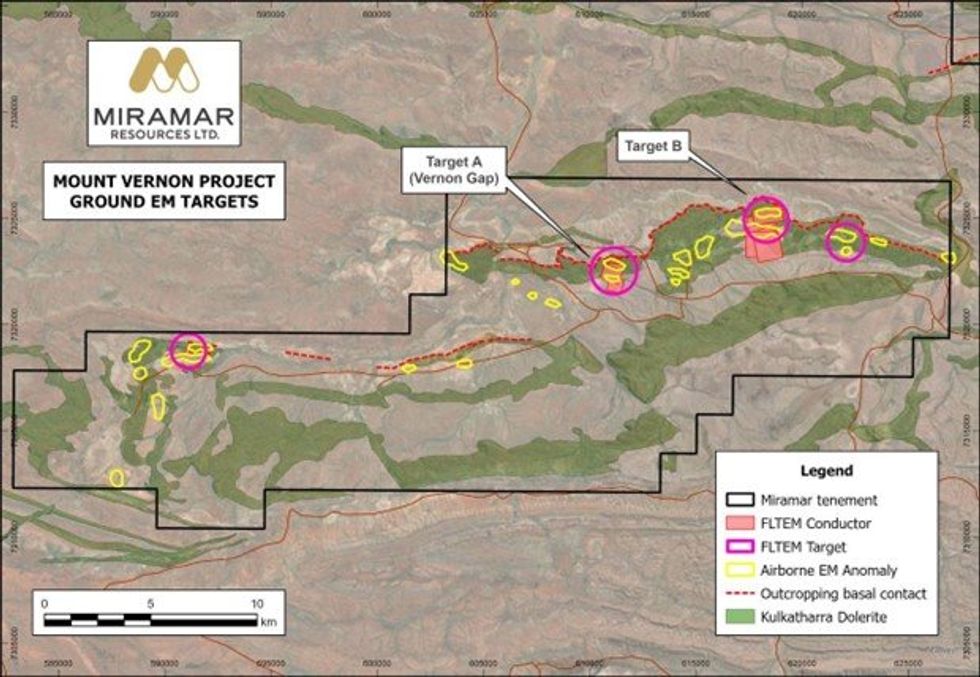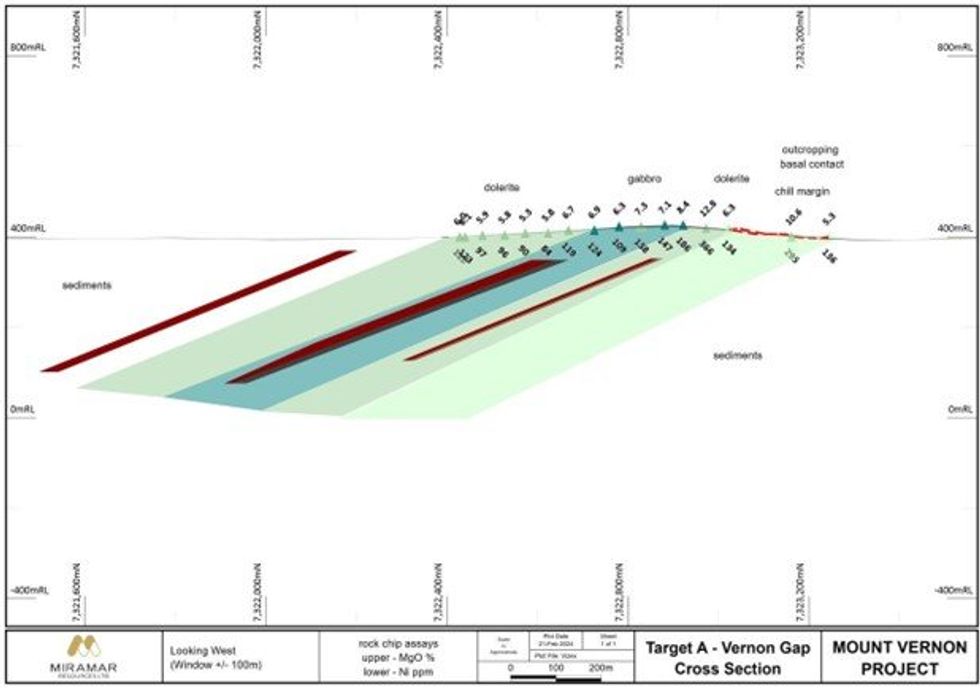
Miramar Resources Limited (ASX:M2R, “Miramar” or “the Company”) is pleased to provide an update on exploration activities within the Company’s large 100%-owned Bangemall Project in the Gascoyne region of Western Australia.
- Fixed loop EM survey continues at Mount Vernon Project
- Evidence of differentiated sill and mafic cumulate rocks
- Shallow EM conductor confirmed at Trouble Bore Project
The fixed loop electromagnetic (FLTEM) survey underway within the Mount Vernon project areas has recommenced after a short break due to extreme weather conditions throughout the Gascoyne region.
As discussed in the ASX release on 13 February 2024, the FLTEM survey at Mount Vernon has so far identified multiple late-time conductors at the first two targets tested to date (Figure 1), with modelling of the data indicating south-dipping conductive plates near the base of the dolerite sill where nickel-copper sulphides may have accumulated (Figure 2).
In addition to the EM results, evidence that the dolerite sill has undergone differentiation, and could therefore host Ni-Cu-PGE sulphide mineralisation, includes the following, as shown in Figure 2:
- Variation in grain size from very fine-grained chill margins at the extremities to coarser-grained gabbro in the centre of the sill.
- Increasing magnesium oxide (MgO), nickel and PGE results towards the bottom (northern margin) of the sill
- Nickel-chromium-titanium (Ni-Cr-Ti) ratios suggesting the presence of mafic cumulate rocks which are an important component of this style of mineralisation
The FLTEM survey will test two further targets within the Mount Vernon Project where strong late-time airborne EM anomalies are seen within and/or underneath the northernmost dolerite sill.
Miramar’s Executive Chairman, Mr Allan Kelly, said the Company believed the Bangemall Project had the potential for a style of Ni-Cu-PGE mineralisation not previously seen in WA.
“We are the first company to explore for this style of mineralisation in the Bangemall region and are systematically progressing our targets towards the maiden drilling programme,” he said.
“At Mount Vernon, we identified multiple targets from our airborne EM survey and have now confirmed two of these with ground EM surveys and rock chip sampling,” he added.
“It is worth noting that, in contrast to many existing WA nickel deposits, the style of mineralisation we are looking for in the Bangemall occurs as large and very valuable orebodies that are basically immune to short-term swings in the nickel price,” Mr Kelly said.
“Like the discovery of Nebo-Babel in 2000, or Nova-Bollinger in 2012, if we can show proof of concept of the Norilsk-style deposit model at Mount Vernon and/or Trouble Bore, it opens up the entire Bangemall region as a new nickel-copper province, one where we have built a dominant landholding,” he added.
 Figure 1. Mount Vernon Project showing airborne EM anomalies and ground EM targets.
Figure 1. Mount Vernon Project showing airborne EM anomalies and ground EM targets.
 Figure 2. Target A cross section showing modelled EM plates (red) and rock chip results.
Figure 2. Target A cross section showing modelled EM plates (red) and rock chip results.
Trouble Bore
Prior to taking a short break due to extreme weather conditions in the region, the geophysical contractors completed a reconnaissance moving loop electromagnetic (MLEM) survey over the 3 kilometre long historic late-time SkyTEM anomaly at the recently granted Trouble Bore Target.
The SkyTEM anomaly occurs at the intersection of a dolerite sill and a potential N-S trending feeder dyke both of which are mostly buried beneath later sediments (Figure 3).
Evidence of the dolerite sill is seen in outcrop along strike in either direction.
A single historic RC hole drilled in 2013 targeted channel iron deposits and did not intersect the dolerite sill or test the SkyTEM anomaly. There is no recorded historical geochemical sampling in the area.
The recent MLEM survey confirmed the historic SkyTEM anomaly, with subsequent modelling suggesting a shallow, sub-horizontal conductor with a moderate conductance of approximately 200 Siemens.
Given the interpreted geological setting of the EM anomaly compared with known Ni-Cu-PGE deposits, especially step 2 of Figure 4, Miramar has submitted a Program of Work (POW) application for drilling at Trouble Bore.
The Company already has POW approval for drilling at Mount Vernon and will apply for co-funding under the WA Government’s Exploration Incentive Scheme (EIS) for drilling at both Mount Vernon and Trouble Bore.
Click here for the full ASX Release
This article includes content from Miramar Resources Limited, licensed for the purpose of publishing on Investing News Australia. This article does not constitute financial product advice. It is your responsibility to perform proper due diligence before acting upon any information provided here. Please refer to our full disclaimer here.
https://ift.tt/WROmiwg









_300xx250.jpg)
0 댓글